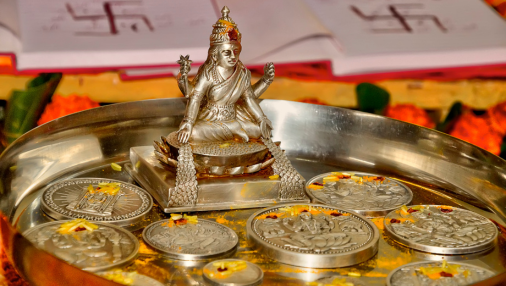The Mythological Significance of Laxmi Puja
According to Hindu mythology, Goddess Laxmi was born from the Kshir Sagar (Ocean of Milk) during the grand event known as the Samudra Manthan — the churning of the ocean by the gods and demons. She emerged seated on a lotus, holding symbols of prosperity and beauty. This divine event marks her eternal connection with wealth, fortune, and abundance.
Diwali night is considered the most auspicious time when she visits homes that are pure, clean, and well-lit with devotion. It is believed that Maa Laxmi blesses households with happiness, prosperity, and progress on this sacred night.
The Spiritual Meaning Behind Laxmi Puja
Though Laxmi Puja is associated with material prosperity, its deeper essence lies in spiritual wealth. The Goddess represents purity, righteousness, gratitude, and self-discipline. True Laxmi resides in homes where people act with honesty, compassion, and a pure heart. Thus, the festival is a reminder to balance spiritual growth with material success.
How Laxmi Puja Is Celebrated
Across India, the rituals of Laxmi Puja follow age-old traditions that symbolize the triumph of light, positivity, and faith.
1. Cleaning and Decoration
Homes are cleaned, painted, and decorated with rangoli, flowers, and lights. Cleanliness symbolizes purity and readiness to welcome Goddess Laxmi. A tidy, glowing home invites her blessings, as it reflects spiritual and moral cleanliness.
2. Lighting Diyas and Lamps
As the sun sets, homes are illuminated with earthen lamps. The light from the diyas represents knowledge and hope, dispelling ignorance and negativity. Every glowing lamp is a prayer to bring divine light into life.
3. The Puja Rituals
The ceremony begins with prayers to Lord Ganesha, remover of obstacles, followed by worshipping Goddess Laxmi and Lord Kubera, the treasurer of heaven. Offerings of sweets, fruits, coins, and flowers are made. Families chant Laxmi mantras and perform Laxmi Aarti to invoke her blessings for health and prosperity.
4. Business and Financial Traditions
Many business communities open new account books called Bahi Khata on Laxmi Puja day. This symbolizes a fresh start for the financial year. Traders and entrepreneurs seek divine guidance for growth and honest earnings.
The Connection Between Diwali and Laxmi Puja
Laxmi Puja is performed on the third day of Diwali, which coincides with the Amavasya (new moon) of Kartik month — the darkest night of the year. Lighting diyas symbolizes the victory of light over darkness, good over evil, and hope over despair. It is also believed that on this day, Lord Rama returned to Ayodhya after defeating Ravana, marking a new era of prosperity and happiness.
The Universal Message of Laxmi Puja
Laxmi Puja teaches us that wealth without wisdom is incomplete. True wealth comes from kindness, selflessness, and gratitude. The festival encourages sharing what we have with others and living with integrity. When we help the needy and spread love, Goddess Laxmi blesses us even more.
Laxmi Puja in Modern Times
Today, Laxmi Puja is celebrated in homes, temples, and workplaces. Many people use eco-friendly decorations and diyas to promote environmental awareness. Acts of charity, feeding the poor, and giving gifts have become integral to modern celebrations, symbolizing the sharing of joy and abundance.
Conclusion: The Light of Prosperity and Purity
Laxmi Puja is not just about calling for wealth; it is about awakening the light within. The glow of diyas reminds us that happiness comes from gratitude, honesty, and compassion. When we live with pure intentions and spread light to others, Goddess Laxmi resides permanently in our hearts and homes.

